This post is sponsored by Little Greene Paint Company
It is almost Christmas which means I am thinking of one thing, yes that’s right DIY. Maybe not the most festive of things to have front of mind, but as we get closer to the end of the year we get closer to something very exciting, well for me at least. My partner and I have been in an incredibly slow, protracted, house purchase process for months and months and, if everything goes to plan, we should finally get the keys in January (the start of a slow renovation process, it’s a real wreck). That of course means I have been dreaming up design schemes for months at this point, I cant help myself, I even have plans room by room. When the paint company Little Greene released a ‘Sweet Treats’ collection I, of course, had to get some samples in, because who doesn't want a room painted the colour of madeleines, ganache or bombolone? The collection is full of warming tones and the colours are gorgeous, so much so that I decided to bake something inspired by one of the colours which we’ll hopefully be using in the house, it’s called Bombolone.
These doughnuts have a gentle festive flavour, its not full on Christmas but they're warming and cosy and perfect for the cold weather. The doughnut starts with a classic brioche dough but thats where tradition ends. The centre of the doughnuts are removed and filled with a butterscotch sauce and a fresh ginger pastry cream, to give the flavour of a sticky toffee pudding, or a gently spiced gingerbread. That would be delicious enough as is, but I took it a little further and bruleed the custard, making these gingerbread creme brûlée doughnuts, or should I say bomboloni!
The base dough is classic, a traditional brioche dough made with lots of eggs and lots of butter. The key to this dough is two fold. Firstly, to make the lightest possible dough, you cannot underestimate the kneading time. Fat is the enemy of proper gluten development so the kneading process is done in two stages. Firstly you need the dough without the butter, giving the gluten time to develop. The second stage is when the butter is added. You need to ensure the butter is fully worked into the dough and then the dough is worked until it becomes strong and elastic again. This whole process can take up to 30 minutes so don’t skimp on the kneading. The second element to working with this dough is that once it is finished its very sticky so instead of struggling to work with it immediately, this dough is refrigerated overnight making the shaping process a million times easier.
The butterscotch filling is incredible simple, a cheats caramel. Instead of melting and caramelising white sugar you add butter and brown sugar to a pan and cook the two together for about 5 minutes. Because you’re starting with brown sugar you already have a warm caramel flavour but, by cooking the butter and sugar together, you deepen the flavour, creating a delicious butterscotch sauce.
The third, and final element, is a classic pastry cream but one that has been infused with fresh ginger. Sure you could use powdered ginger and make the process faster but I love the flavour of fresh ginger, it is brighter and more zingy, less aggressive and less spicy. The flavour is added by a classic infusion, the milk for the pastry cream is brought to a simmer with the ginger and then left for at least an hour (a couple hours is better) to infuse. The ginger is then strained out and the pastry cream made as you would normally.
Together you have one delicious doughnut and whilst there are a few elements this would make a brilliant festive project when you want to stay inside and hibernate.
Winter Gingerbread Brioche Doughnuts
Makes 12 Big Doughnuts
You can make 16 slightly smaller doughnuts if you prefer
Brioche
500g strong white bread flour
50g light brown sugar
1 tsp fine salt
7g dried fast action yeast
4 large eggs
150ml whole milk
250g unsalted butter, diced and at room temperature
Fresh Ginger Pastry Cream
500ml whole milk
30g grated fresh ginger
2 large eggs
4 large egg yolks
200g caster sugar
50g cornflour
Butterscotch Sauce
85g unsalted butter, diced
150g light brown sugar
1/2 tsp flaked sea salt
1 tsp vanilla extract
120ml double cream
For the pastry cream place the milk, ginger and half of the sugar into a saucepan. Place the pan over medium heat and bring to a simmer. Turn off the heat, add a lid to the pan and set aside for at least an hour to infuse. When ready to make the pastry cream bring the milk back to a simmer and then pour through a fine mesh sieve to strain out the ginger.
Add the vanilla and milk mixture back into the saucepan and bring to a simmer. Meanwhile add the eggs, yolks, cornstarch and the remaining sugar to a large bowl and whisk together until smooth. Once the milk mixture is at temperature remove from the heat and pour over the egg mixture whilst whisking to combine, to prevent the eggs from scrambling. Pour the custard mixture back into the saucepan and place over medium/high heat and cook, whisking constantly, until the custard has thickened. Allow the custard to cook for a further minute or two, to ensure the cornstarch is fully cooked out. Scrape the custard back into the bowl and press a sheet of clingfilm onto the surface of the custard and refrigerate until fully chilled, at least four hours. The pastry cream can also be prepared a day ahead if you prefer.
To make the brioche dough place the flour, light brown sugar, salt and yeast into the bowl of a stand mixer, fitted with the dough hook and mix together to combine. Pour in the milk and the eggs and with the mixer turned to low, mix together to form a shaggy dough. Knead on low/medium speed for about 10-15 minutes or until the dough is elastic and pulling away from the sides of the bowl. Add the butter, a couple pieces at a time, and mix until the butter is fully combined. Once the butter has been combined, continue to knead until the dough is elastic again and pulling away from the sides of the bowl. This will take another 10-15 minutes.
At this stage place the dough into a lightly greased bowl, covering with clingfilm, and set aside for 45 minutes at room temperature before transferring to a the fridge to rest overnight.
Tip out the risen dough and divide into 12 equal sized pieces and form into rounds. Set each ball of dough onto a square of parchment paper and flatten slightly with the palm of your hand, before rolling into a thick flat disc. Lightly cover with clingfilm and allow to rise, until almost doubled in size. This can take 2-3 hours, depending on the temperature of your kitchen. To test if the doughnuts are ready for frying, press one with a lightly floured finger. It should spring back slowly, if it springs back quickly it needs to rise longer and if holds it shape it has over proofed.
To make the butterscotch sauce, place the butter and sugar in a medium pan and cook over a medium heat until melted and bubbling. Cook for a further 2-3 minutes, to deepen the flavour, then stir in the salt, vanilla extract and double cream. Simmer for 30 seconds, then pour into a heatproof container and set aside until needed.
Fill a large saucepan about 1/2 full with a neutral oil and heat over medium heat to 175ºC-180ºC. Once the oil is at temperature turn the heat down to low so that the heat stays steady between 175ºC-180ºC. Add the doughnuts 2 at a time (more if you can fit them) frying for about 5 minutes, flipping half way through cooking, until the doughnuts are a deep golden brown. Set the doughnuts onto a plate lined with kitchen roll to drain any excess oil. Whilst still a little warm toss in sugar. Set aside and allow to cool fully.
To assemble the doughnuts use a 5cm round cookie cutter to cut out the centres of the doughnuts. If your cookie cutter isn’t sharp use it to mark a template and use a knife to cut out the centre, using your fingers to pull out the dough, leaving behind a deep well ready to be filled. Spoon in the butterscotch sauce into the middle of the doughnuts.
Remove the pastry cream from the fridge and beat with a spatula until silky and smooth. Pipe or spoon the custard atop the butterscotch, generously filling up the doughnuts. Sprinkle a little sugar on top of the custard and then use a kitchen blowtorch to melt and caramelise the sugar.
Once assembled the doughnuts are best served within a couple hours.

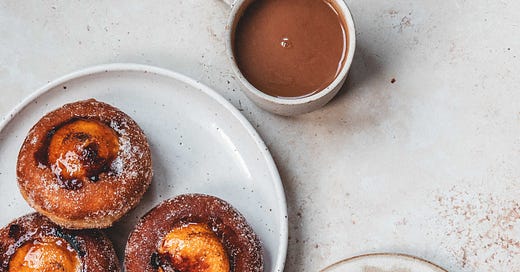




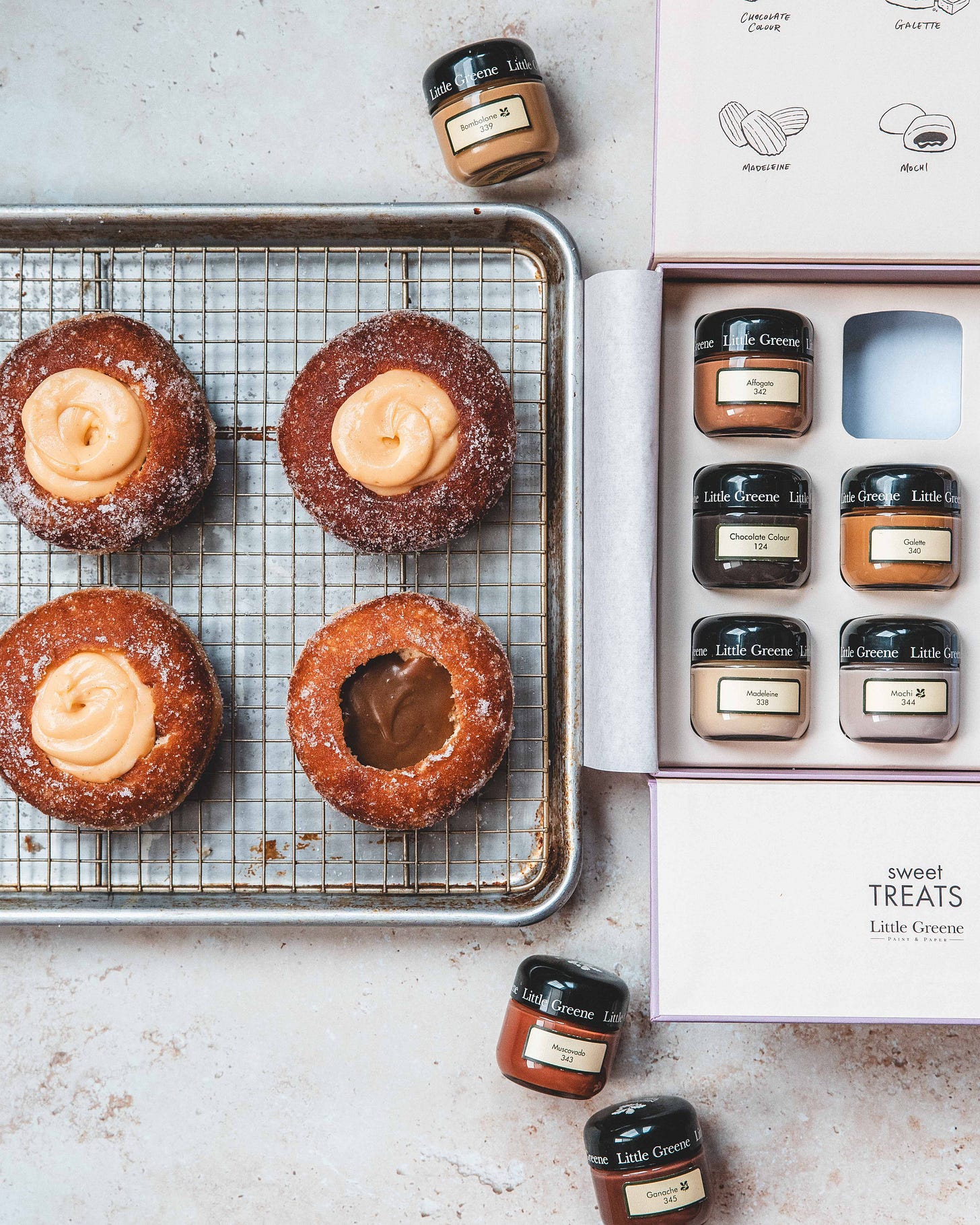
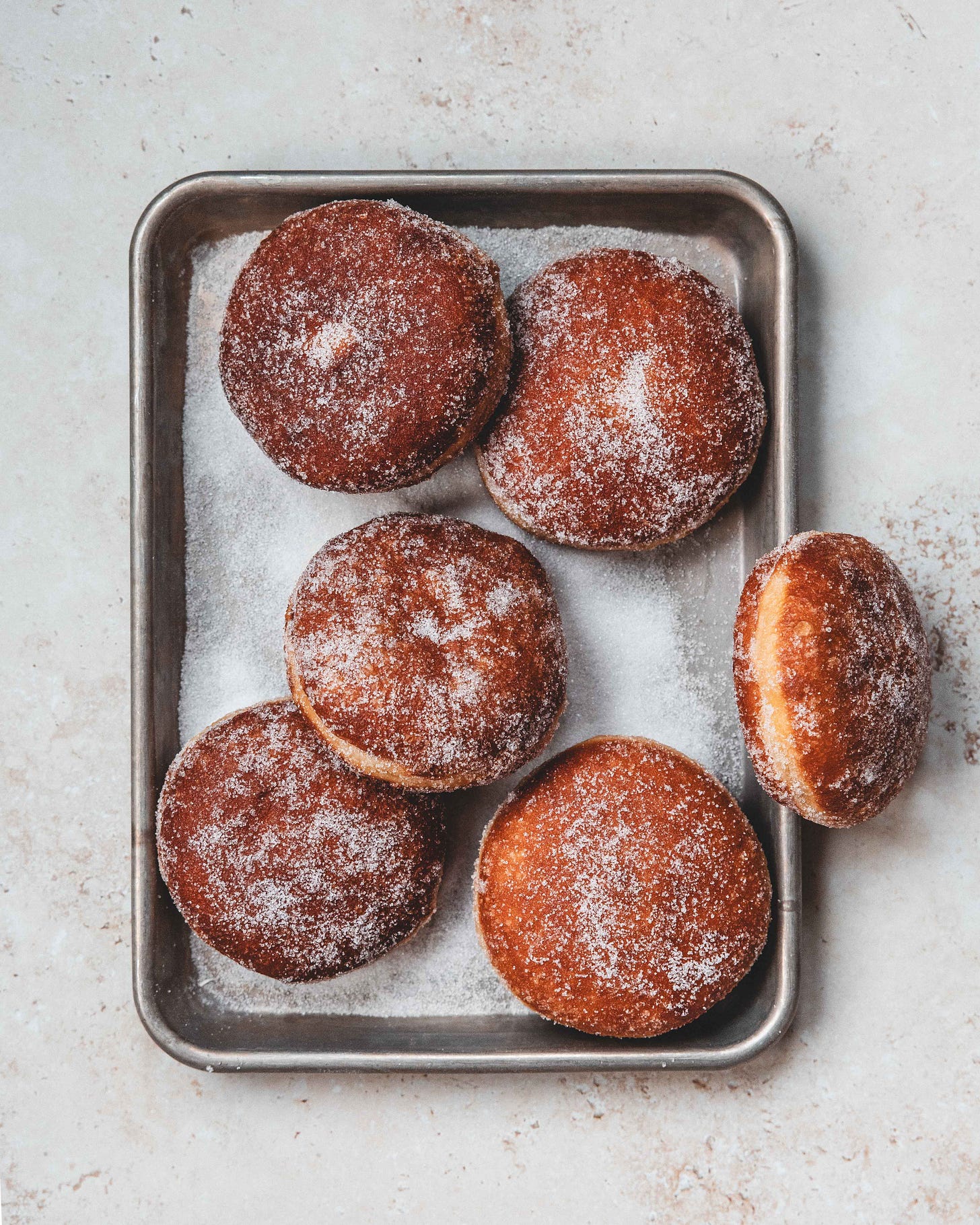
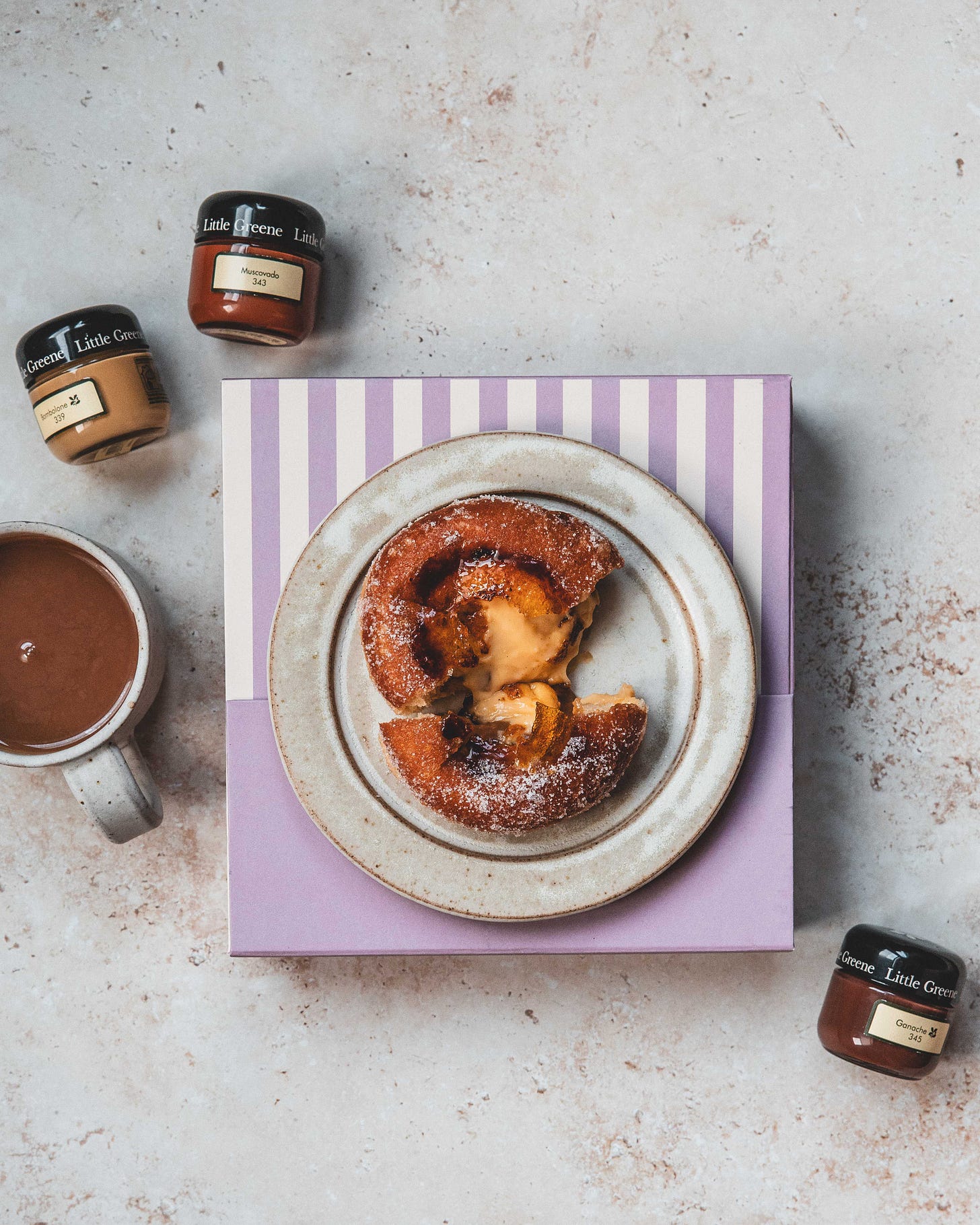
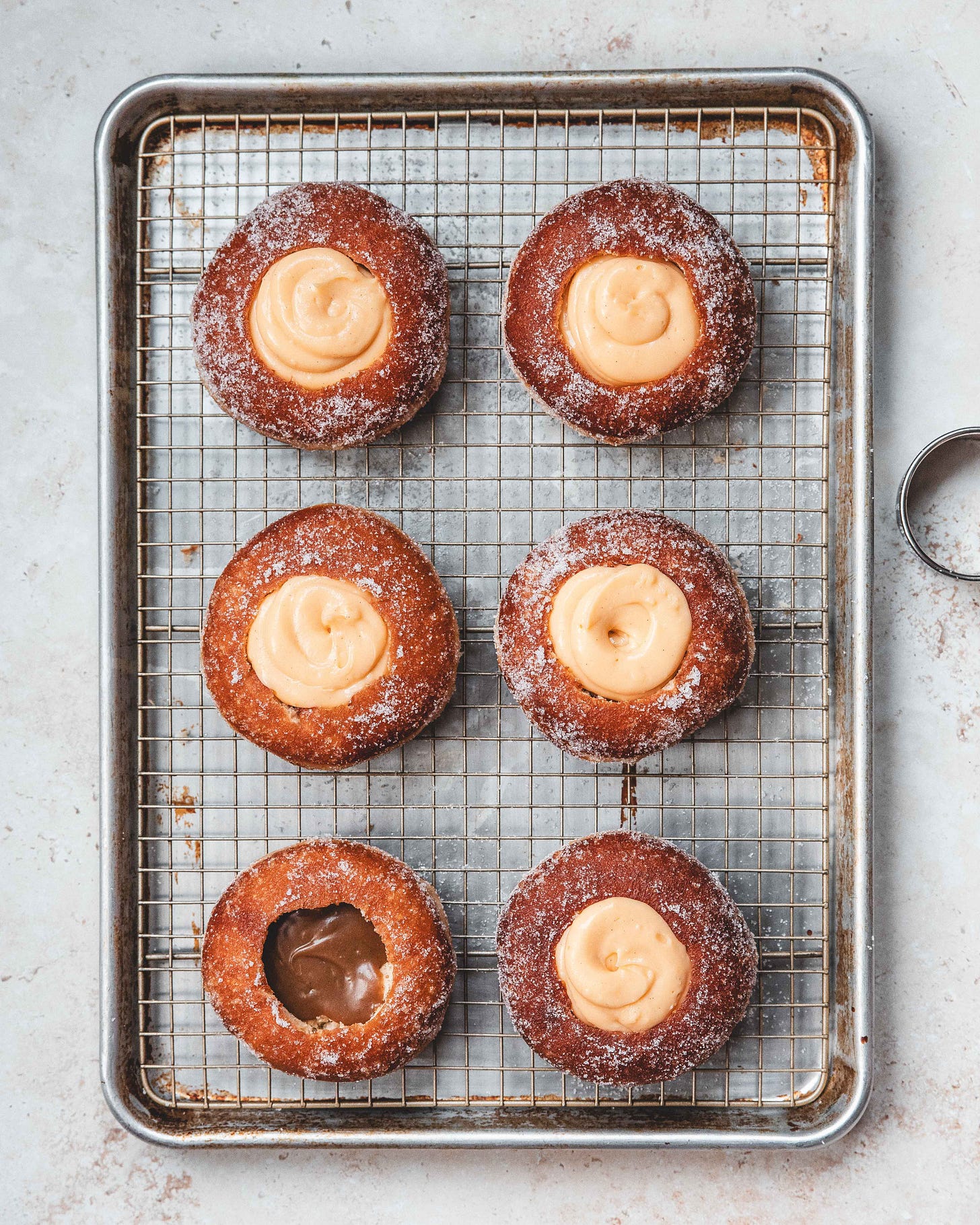
This sounds amazing. I might make this into profiteroles!